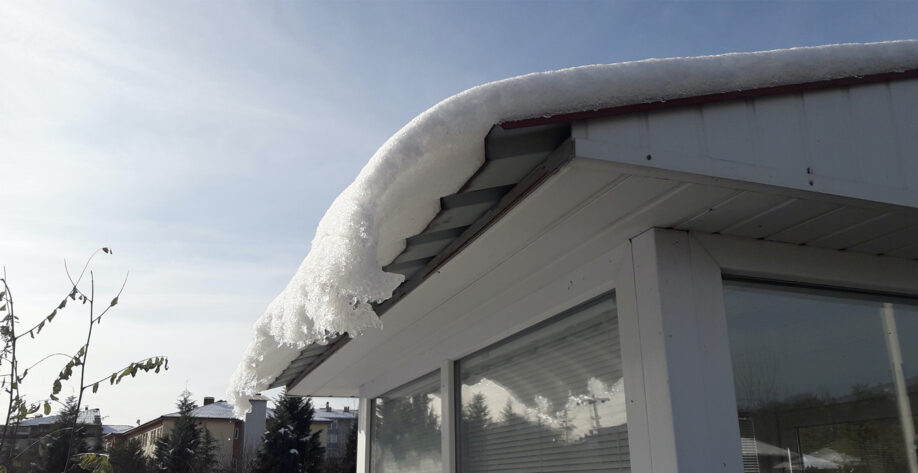With considerable snowfall forecast this year, it is important that building owners and managers pay close attention to their roofs to avoid potential collapse.
Roof snow loads are based upon various factors including the regional ground snow load, exposure factor of the building, and whether the building is heated, insulated, and/or occupied. Additional factors, such as geometry of the roof, pitch, roof covering, and unbalanced loading, also affect the design snow loads. Drifting can occur on roofs adjacent to rising walls, at roof projections or adjacent buildings, including those created by building additions or modifications.
Snow loads on roof structures can vary considerably from state-to-state and region-to-region within a state. For example, using a 100 ft. wide, flat roof, heated and occupied office building, the following flat roof design loads are required by code (ref: ASCE 7-10)
With rain on top of the snow layer, or snow on top of the ice layer, the density of the snow and resulting load to the roof can be significantly increased. The roof framing could be structurally overstressed if the snow load is more than that carried by design. Likewise, the depth of allowable snow on the roof could be greatly reduced if ice or additional moisture is present in the snow layer.
To monitor and help safeguard against excessive snow overload of roof structures, building owners and managers may wish toconsider performing the following steps:
- Check the original design documents to determine if the roof was properly designed. The General Notes of many structural drawings state the design roof live load, the design snow load, and a statement about “drifting conditions.” Contact a structural engineer if there are questions regarding the “as-built” construction and structural capacity. A cursory review of the building should be performed by the structural engineer to verify that the building was generally constructed in accordance with the documents.
- Review subsequent renovation/modification drawings for conditions that could result in additional loading as a result of ponded water and drifting snow. Ponding conditions due to renovations or additions are typically the result of impeding the originally designed drainage patterns (i.e. a structure or roof-mounted unit is placed in an area that blocks the existing drains). Drifting conditions can result from screen walls, new structures, or equipment.
- Verify roof drainage capacity and the existing drains/scuppers are not frozen, which can impede the drainage from the roof. If necessary, clear the drains to promote free flow. Frozen drain lines will impede drainage, which may result in broken pipes. A heat-trace system to keep open flow can be considered. Consult a roofing professional if the drains appear to be undersized or incorrectly located to remove most of the water. Small ponded areas can have a detrimental effect on the roofing membrane, while large or deep ponded areas may have serious structural implications known as ponding instability. If snow or live loading results in structural deflection or creep in the structure, additional ponding may result, which ultimately could impact the capacity of the structure.
- Observe the interior of the roof structure for potential deflections. Observe the ceiling, lighting, HVAC, and plumbing components, and monitor changes such as vertically-deflected sprinkler heads or displaced ceiling grids (suspended ceilings), which indicate possible deflection of the structure. These components are typically suspended from the roof framing and may indicate that the roof is experiencing deflection. If this condition is observed, remove snow from the roof as soon as possible, and seek advice from a structural engineer to determine whether the building is safe to occupy. For gypsum deck or wood deck roof systems, inspect spot locations to determine if there appears to have been a disturbance of original paint lines, dust lines, dirt lines, etc., which could indicate that the deck has been displaced from its support elements (bulb tees, joists, etc.). Look for deflected or cracked deck elements. Review exterior conditions for oxidized (rusted) metal decking or joists, sagging wood decks or saturated wood framing, or concrete supports that are spalled or delaminated. A structural engineer should analyze cracked beams, deflected joists, and damaged or deflected decking immediately.
- Determine a safe depth of snow for the roof in general and some specific drifting areas. Monitor the roof during heavy snowstorms to check that safe snow depths are not exceeded. A 1.5′ depth of snow will result in an approximate snow load of 31.5 psf and more if the snow contains ice or additional moisture. This will be particularly critical in snow drift locations for buildings designed prior to the 1970s, which may have been designed without consideration for drifting loads.
- Develop a snow removal plan. If it is structurally safe to do so, consider shoveling snow off the roof onto the ground and not onto adjacent roof areas. Unbalanced and excessive snow loading may damage or overload the structure. Remember that the roof is going to be slippery and consider the safety of the workers when deciding if the snow should be removed (and use appropriate fall protection equipment). Take care not to damage the roof membrane during removal operations. Do not torch snow as a means to melt the snow as this may create a fire hazard and additional ponding may result if drainage is impeded. Do not add water to the roof system in an attempt to melt the snow away. Water presents a very dynamic loading condition, and unbalanced snow loading, poor drainage and ponding may worsen the loading. Remove pieces of ice and icicles from the roof and roof edges with care and at a distance to avoid injury. Do not use de-icing chemicals on the roof. These harsh chemicals may harm the roof materials, drain systems, and associated roofing items. Do not use snow blowers, tractors, or other machinery that will add load to the structure.
- Free standing canopies, attached canopies, and overhangs are especially susceptible to excessive loading of snow. Keep the areas beneath the canopy clear. Structurally shore up areas that may be in danger of collapse if it can be performed safely.
Tagged In:
Building Enclosure Design & Consulting
